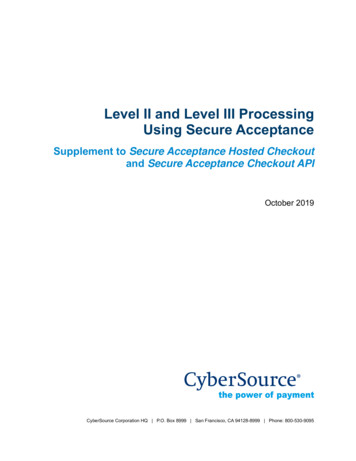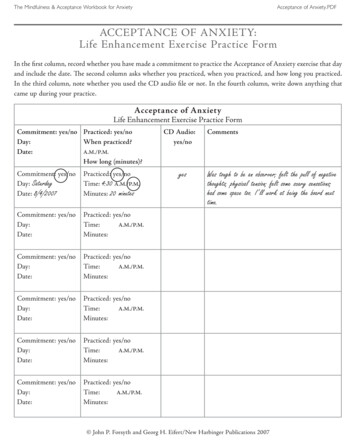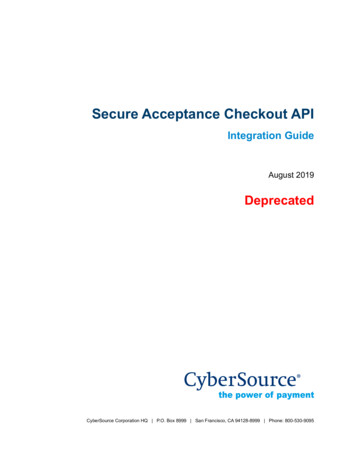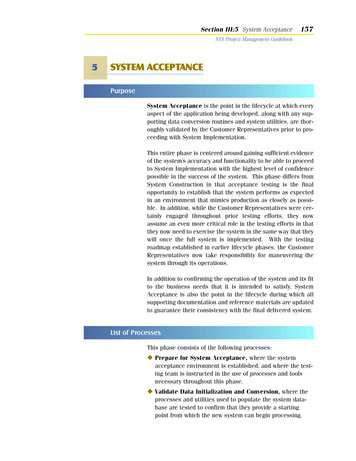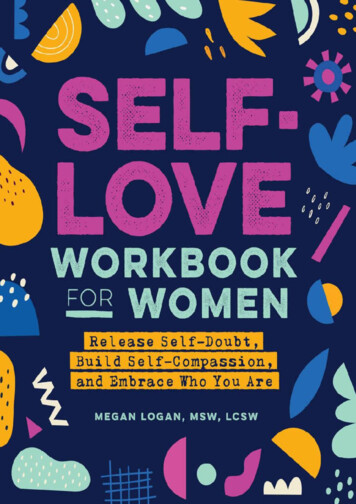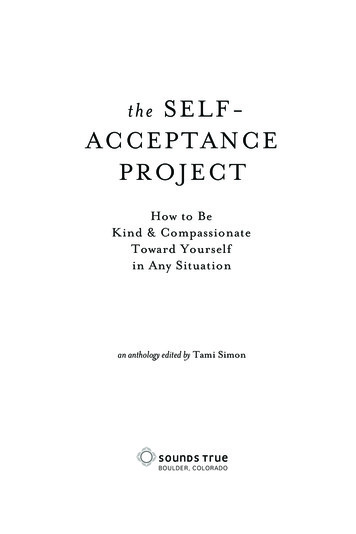
Transcription
t he SEL F-ACCEPTAN C EPROJ ECTHow to BeKind & CompassionateToward Yourselfin Any Situationan anthology edited by Tami SimonBOULDER, COLORADO
CONTENT SIntroduction by Tami Simon . . . ixPRACTICING SELF-ACCEPTANCE1 Waking Up from the Trance of Unworthiness . . . 3Tara Brach, PhD2 Healing at the Level of the Subconscious Mind . . . 11Friedemann Schaub, MD, PhD3 Beautiful, Necessary, Exquisite Emotions . . . 21Karla McLaren, MEd4 Perspective-Taking as Healing . . . 29Steven C. Hayes, PhD5 Embracing All of Our Parts . . . 39Jay Earley, PhD6 Moving Toward a Wise Mind View . . . 47Erin Olivo, PhD, MPH7 Curiosity Is the Key . . . 55Harville Hendrix, PhD, and Helen LaKelly Hunt, PhDv
C O NTE NT SEMBODYING SELF-ACCEPTANCE8 Compassion for the Self-Critic . . . 67Kristin Neff, PhD9 Staying Loyal to One’s Self: Inhabiting the Body . . . 77Judith Blackstone, PhD10 Not Self-Acceptance, but an Accepting Self . . . 83Bruce Tift, MA, LMFT11 Held, Not Healed: The Joy of Beginning Again . . . 91Jeff Foster12 What If There Is Nothing Wrong? . . . 101Raphael Cushnir13 More on the GPS from the Twilight Zone . . . 111Geneen RothAWAKENING SELF-ACCEPTANCE14 No Strangers in the Heart . . . 123Mark Nepo15 Taking In the Good . . . 131Rick Hanson, PhD16 Transforming Self-Criticisminto Self-Compassion . . . 139Kelly McGonigal, PhD17 Perfect in Our Imperfection . . . 147Colin Tippingvi
C O NTE NT S18 Disempowering Our Inner Critic . . . 157Robert Augustus Masters, PhD19 Faith in Our Fundamental Worthiness . . . 171Sharon SalzbergReferences . . . 179About the Contributors . . . 181vii
practicingS E LF - AC C E PT AN CE
1W A KING U P FR O M THETRANCE OF U NW O RT HI NE SSTara BrachBuilding a true sense of self-trust comes from making contactwith the deeper parts of our being, such as the truth of ourloving, even when we sometimes act in ways we don’t like.Many years ago, I began to focus on the urgent need for selfacceptance. In fact, I called it radical self-acceptance, becausethe notion of holding oneself with love and compassion wasstill so foreign. It had become clear to me that a key part of my emotionalsuffering was a sense of feeling “not enough,” which, at times, escalatedinto full-blown self-aversion. As I witnessed similar patterns in my students and clients, I began to realize that the absence of self-acceptance isone of the most pervasive expressions of suffering in our society.We can spend huge swaths of our life living in what I call the“trance of unworthiness,” trapped in a chronic sense of falling short.Though we’re rarely conscious of it, we continually evaluate ourselves.So often, we perceive a gap between the person we believe we shouldbe and our actual moment-to-moment experience. This gap makes usfeel as if we’re always, in some way, not okay. As if we’re inherently deficient. A palliative caregiver who has worked with thousands of dyingpeople once wrote that the deepest regret expressed by her patients isthat they hadn’t been true to themselves. They’d lived according to the3
T HE SE L F- AC C E P TANC E P R O J E C Texpectations of others, according to the should, but not aligned withtheir own hearts.That speaks volumes. We can move through our days so out oftouch with ourselves that, at the end, we feel sorrow for not havingexpressed our own aliveness, creativity, and love.So much of the time we’re simply unaware of just how pervasivethat sense of something’s-wrong-with-me is. Like an undetected toxin,it can infect every aspect of our lives. For example, in relationships,we may wear ourselves out trying to make others perceive us in a certain way — smart, beautiful, spiritual, powerful, whatever our personalideal happens to be. We want them to approve of us, love us. Yet, it’svery hard to be intimate when, at some deep level, we feel flawed ordeficient. It’s hard to be spontaneous or creative or take risks — or evenrelax in the moment — if we think that we’re falling short.From an evolutionary perspective, a sense of vulnerability is natural.Fearing that something’s wrong or about to go wrong is part of thesurvival instinct that keeps us safe — a good thing when we’re beingchased by a grizzly bear! Although this sense of vulnerability — ofbeing threatened — is innately human, all too often we turn it in onourselves. Our self-consciousness makes it personal. We move quicklyfrom “Something is wrong or bad,” to “I’m the one who’s wrong orbad.” This is the nature of our unconscious, self-reflexive awareness;we automatically tend to identify with what’s deficient. In psychological parlance, this scanning for and fixating on what is wrong isdescribed as “negativity bias.”For most of us, our feelings of deficiency were underscored by messages we received in childhood. We were told how to behave and whatkinds of looks, personality, and achievements would lead to success,approval, and love. Rarely do any of us grow up feeling truly loveableand worthy just as we are.Our contemporary culture further exacerbates our feelings of inadequacy. There are few natural ways of belonging that help to reassure usabout our basic goodness, few opportunities to connect to somethinglarger than ourselves. Ours is a fear-based society that over-consumes,is highly competitive, and sets standards valuing particular types of4
W A KI NG UP FRO M THE T RANC E O F U N W O R T H I N E S Sintelligence, body types, and achievements. Because the standards areset by the dominant culture, the message of inferiority is especiallypainful for people of color and others who are continually faced withbeing considered “less than” due to appearance, religion, sexual orgender orientation, or socio-economic status.When we believe that something is inherently wrong with us, weexpect to be rejected, abandoned, and separated from others. In reaction, the more primitive parts of our brain devise strategies to defendor promote ourselves. We take on chronic self-improvement projects.We exaggerate, lie, or pretend to be something we’re not in order tocover our feelings of unworthiness. We judge and behave aggressivelytoward others. We turn on ourselves.Although it’s natural to try to protect ourselves with such strategies,the more evolved parts of our brain offer another option: the capacity to tend and befriend. Despite our conditioning, we each have thepotential for mindful presence and unconditional love. Once we see thetrance of unworthiness — how we’re suffering because we’re at war withour self — we can commit to embracing the totality of our inner experience.This commitment, along with a purposeful training in mindfulnessand compassion, can transform our relationship with all of life.It’s helpful to understand that when we’re possessed by fearful reactivity, we can be hijacked by our primitive brain and disconnectedfrom the neuro-circuitry that correlates with mindfulness and compassion. We become cut off from the very parts of ourselves that allow usto trust ourselves, to be more happy and free. The critical inquiry iswhat enables us to reconnect — to regain access to our most evolved,cherished human qualities.The gateway is the direct experience of the suffering of fear andshame that have been driving us. Not long ago, one of my studentsrevealed that she felt as if she could never be genuinely intimate withanother person because she was afraid that if anyone really knew her,they’d reject her outright. This woman had spent her whole life believing, “I’ll be rejected if somebody sees who I am.” It wasn’t until sheacknowledged her pain and viewed it as a wake-up call that she couldbegin to stop the war against herself.5
T HE SE L F- AC C E P TANC E P R O J E C TOnce we recognize our suffering, the first step toward healing islearning to pause. We might think, “I’m unworthy of my partner’s lovebecause I’m a selfish person.” Or, “I’m unworthy because I’m not afun or spontaneous person.” Or perhaps, “I don’t deserve love becauseI always let people down.” We might experience feelings of shame orfear or hopelessness. Whatever our experience, learning to pause whenwe’re caught in our suffering is the critical first step. As Holocaust survivor and psychiatrist Viktor Frankl famously said: “Between stimulusand response, there is a space. In that space is our power to chooseour response. In our response lies our growth and freedom.” Whenwe pause, we can respond to the prison of our beliefs and feelings ina healing way.The second step toward healing is to deepen attention. It’s important to ask, “Beneath all of my negative thoughts, what’s going on inmy body, in my heart, right now?” When we begin to bring awareness to the underlying pain, I sometimes call that the sense of “ouch.”You might even ask how long it’s been going on and realize: “Wow.I’ve been feeling not enough for as long as I can remember.” If thathappens, try placing your hand on your heart as a sign of your intention to be kind toward yourself and your suffering. You might eventell yourself, “I want to be able to be gentle with this place inside methat feels so bad.”For most of us, staying with the “ouch” can be painful and grueling;it can wear down our spirit and energy. The reason I suggest puttinga hand on our heart is that a gesture toward ourselves that expressescomfort or healing has real power. If being with yourself in that wayis uncomfortable, imagine someone who is truly wise and compassionate helping you; this can serve as a bridge to bringing the healingpresence to yourself.When we do this, a shift begins to occur. We move from beingidentified with the unworthy self to a compassionate presence thatwitnesses and is with the unworthy self. That shift is a movementtoward freedom. It’s in that very moment when we become presentand offer kindness — or the intention of kindness — to ourselves thatreal transformation begins to take place.6
W A KI NG UP FRO M THE T RANC E O F U N W O R T H I N E S SI’ve experienced many triggers for my own trance of unworthiness.One of the most powerful in recent years was a long stretch of illness.Not only did I feel sick, but I would often become irritable and selfcentered, then stop liking myself for being a bad sick person. It felt as ifI were not being very spiritually mature in dealing with my illness. TheBuddha called this the second arrow. The first arrow is, “Oh, I feel sick.”In other words, just what is. The second arrow is the sense of unworthiness we inflict upon ourselves — in my case, being a bad sick person.When I experienced a sense of personal failure, of not being agood person, I’d pause, put my hand on my heart, and imagine anunderstanding presence around me, pouring care through my hands.Sometimes I’d mentally whisper the words “It’s okay, sweetheart” or“I’m sorry, and I love you.” Although at first I was invoking a largerpresence to offer care to the bad sick person, as I relaxed, it becameclear that the loving presence I’d invoked was intrinsic to my own heart.This process of reconnecting to our sense of goodness and worthiness that I’ve described is based on two key elements — mindfulrecognition of what’s going on inside us, and a compassionate response.Many people have found that the practice of R-A-I-N offers an easyway to do this: R is to recognize what’s going on. Pause and acknowledgeall the thoughts and feelings of unworthiness. A is to allow, which means we allow the thoughts andfeelings to be there. We deepen the pause. We don’t try todistract ourselves or get away from what’s happening. Welet it just be, so that we can deepen into the “I” of RAIN. I is to investigate with kindness. We bring a gentle, yetinterested attention to our experience. This is where westart loosening the grip of the trance. Here’s where youcan put your hand on your heart and offer yourself amessage of compassion, or open to receive the lovingpresence from the larger energy field to which we belong.7
T HE SE L F- AC C E P TANC E P R O J E C T N means not-identified. This may sound like a dry term,but it signifies true liberation. When we don’t identifywith that unworthy self, we’re free to inhabit ourwholeness, free to inhabit the loving awareness that wasclouded over, but always there.RAIN is a process of disentangling from the trance. What it reallycomes down to is mindful awareness with kindness. The more I practice RAIN in my own life, the less lag time there is between gettingstuck and relaxing open into a larger, freer sense of being. RAIN hashelped me catch the ideas and feelings that have to do with an unworthy self, and then to realize that I don’t have to believe them! Thefeelings are there, the thoughts are there, but the sense of who I am isbeyond any limiting story of self. I’ve learned to trust the beingness thatis here, a loving presence that isn’t stained or diminished by thoughtsor feelings of unworthiness.I’ve seen how, for myself and many others, even when we’ve beenfilled with self-hate or blame, we can find our way back to kindness. Ametaphor I find helpful is to imagine you’re in the woods and you seea dog by a tree. You go over to pet the sweet dog and it springs at yousuddenly — growling, with fangs bared. In an instant, you switch fromwanting to pet the puppy to being really angry and afraid. Then younotice that the dog has caught its leg in a trap under a pile of leaves, soyou switch again, from anger and fear to care and compassion. If wecan pause and recognize that in some way our leg is in a trap, if we cansee that the behavior we’ve been harshly judging in ourselves is comingfrom our pain, then we soften. We regain access to a natural tendernesstoward our own suffering, and with that, open back into a more fulland compassionate presence toward all beings.Along with recognizing our vulnerability, self-acceptance arises aswe deepen trust in our essential goodness. A woman once came up tome after a class and said, “I’m at war with myself because of the wayI’m treating my five-year-old daughter. I’m bursting out in anger allthe time and criticizing her, and I don’t deserve to accept myself. Howcan I trust myself if I’m doing this?” She was afraid that accepting or8
W A KI NG UP FRO M THE T RANC E O F U N W O R T H I N E S Sforgiving herself would just perpetuate being a bad mother. We all actin ways that are harmful at times, and reacting with self-punishmentand self-hate is not a pathway toward more wise behavior.I asked her, “Do you love your daughter?”Tears sprang up as she answered. “Of course! I wouldn’t be so upsetabout this if I didn’t love my daughter.”“Spend some time reflecting on loving her, what you love about her,”I suggested. “Feel that loving awareness in you, and get to know thatas the place you can trust.”That really resonated with her because intuitively she understoodthat while she couldn’t trust her ego, she could trust her heart. If wethink we should be able to trust our ego-self, it’s not going to work.The ego-self is unreliable, out of control, causes trouble, strives, and isafraid. Building a true sense of self-trust comes from making contactwith the deeper parts of our being, such as the truth of our loving,even when we sometimes act in ways we don’t like.We are each on a path of awakening to loving the life that is here.Though we might call it self-acceptance, what we’re accepting is thisfeeling — this hurt, this sadness, this fear, this anxiety, and this sense ofdoing something wrong. As we grow to accept and embrace this livingreality — its pleasantness, its unpleasantness — the illusion of a separateself dissolves. We discover the radiance and love that is our essence.The more we trust this essence, the more we recognize that same goodness and spirit in all beings. Our embrace of our inner life widens toan authentic and unconditional love for this living world.9
2HEAL ING A T THE L E VE LO F THE S U BCONS C I O US M I NDFriedemann SchaubThe good news is that pain, whether physicalor emotional, can function as a powerful catalystfor healing, change, and growth.The discussion about the absence of self-compassion andself-acceptance may be even more imperative now than ithad been for previous generations. The demands of modernsociety have trained us to constantly comply, compete, and compareourselves with others and consequently derive our worthiness mainlythrough external perspectives, judgments, and validations. Life is nolonger considered a journey — it has become a competition, a race,with no apparent reward or finish line to reach.This externally focused way of living has been accelerated by theomnipresent media, increased societal pressures, and new ways of communicating that prevent us from taking the time to relax and develop arelationship with ourselves. Consequently, we feel increasingly pulledout of our center and lose touch with our authentic selves. We nolonger search for our truth, our unique potential, and our purpose forbeing here. Most of our energy goes to competing, winning, or at least“fitting in,” instead of exploring the unique gifts and talents we canexpress and share with the world.11
T HE SE L F- AC C E P TANC E P R O J E C TThe dramatic increase in the number of people suffering from fear,anxiety, and depression in the last decades is a direct reflection of howmany of us struggle with the painful lack of inner peace and selfacceptance. The good news is that pain, whether physical or emotional,can function as a powerful catalyst for healing, change, and growth.The current level of pain, anxiety, and depression in our society offersa huge opportunity for growth on a larger scale, and it is encouragingto see that more and more people recognize that the path to harmony,peace, and fulfillment leads them within.One of the first steps toward self-acceptance and self-compassion isto become aware of how our self-talk can be based in judgment, worry,and self-doubt. Without hesitation or remorse, we scare ourselves, putourselves down, and even call ourselves names in ways we would neverdare to treat anyone else, especially not someone we care about. Butwhat can we do to make this insecure, critical, or negative inner voicestop? Should we ignore it, get angry, and fight it — or should we acceptthat its self-berating or self-doubting messages are true?In my practice, I am helping people to understand how our subconscious influences our emotions and behaviors — and how we canaccess this deeper part of our mind to overcome and heal fear, anxiety,and depression. One of the keys to healing these emotional challengesis to identify and address the subconscious self-protective patterns,which keep us in survival mode and prevent us from thriving andliving more fulfilling lives. Most of our negative self-talk stems fromour subconscious mind. It is important to understand that the purpose of those self-bashing, anxiety-triggering thoughts is not to hurt usor to make us feel bad about ourselves. The purpose of this inner voiceis ultimately to protect us.When we listen to our negative monologue, we may sometimeshear echoes of our childhood. Some of my clients tell me their innercritic sounds exactly like their father or uncle or teacher. Others feelthat the inner voice that always expects the other shoe to drop remindsthem of their anxious mothers or grandmothers. Our subconsciousmind replays those tapes of the past to prevent us from having toendure failure, hurt, rejection, or abandonment. Let’s say, for example,12
Building a true sense of self-trust comes from making contact with the deeper parts of our being, such as the truth of our loving, even when we sometimes act in ways we don’t like. M any years ago, I began to focus on the urgent need for self-acceptan


